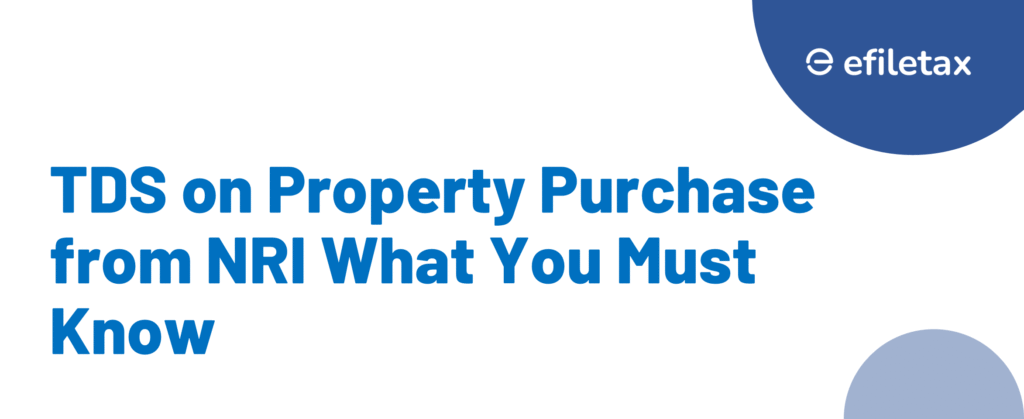
Buying Property from an NRI? TDS Rules You Can’t Ignore
If you’re buying property from an NRI, TDS on property purchase from NRI must be handled before you pay. This isn’t your standard 1% TDS like with Indian sellers. Here, the rate can go as high as 20%–23.92%, and non-compliance attracts hefty penalties.
Let’s break it down so you don’t end up facing a tax notice or blocking your funds unnecessarily.
Why is TDS Applicable on NRI Property Sale?
Under Section 195 of the Income-tax Act, 1961, any person making payment to a non-resident (including for property purchase) must deduct TDS on the income portion of that payment.
Since the seller is earning capital gains (short-term or long-term), TDS applies — even if you’re just a buyer.
TDS Rates for Property Purchase from NRI
| Type of Capital Gain | Holding Period | TDS Rate (FY 2024-25) |
|---|---|---|
| Short-Term Capital Gain | < 2 years | As per slab rate (up to 30%) + surcharge + cess |
| Long-Term Capital Gain | ≥ 2 years | 20% + surcharge + 4% cess = up to 23.92% |
📌 Important: TDS is deducted on total sale consideration, not just the capital gain.
Step-by-Step Guide to TDS Compliance for Buyers
1. Verify Seller’s Residential Status
Ask for their passport, PAN, and utility bills to confirm NRI status under Section 6.
2. Apply for TAN
You, the buyer, must obtain a TAN (Tax Deduction Account Number) under Section 203A using Form 49B.
3. Deduct TDS before Payment
TDS must be deducted before any payment to the NRI seller. Deduct at the correct rate (consult a CA if unsure).
4. Deposit TDS with the Government
Use Challan No. ITNS 281 and pay via NSDL (now Protean) portal within 7 days of month-end in which deduction was made.
5. File Form 27Q
This is the quarterly TDS return for payments to NRIs. Mandatory.
6. Issue Form 16A
After filing 27Q, provide Form 16A (TDS certificate) to the NRI seller.
Can TDS Be Reduced or Nil?
Yes, under Section 197, the NRI seller can apply to the Assessing Officer (AO) for Lower or Nil TDS Certificate in Form 13.
Once approved, you can deduct TDS at the reduced rate mentioned in the certificate.
What If You Miss TDS?
Here’s what can happen:
- Buyer becomes assessee-in-default
- Interest under Section 201(1A):
- 1% per month for non-deduction
- 1.5% per month for non-payment after deduction
- Penalty under Section 271C: Equal to TDS not deducted
- Prosecution (in extreme cases)
*CBDT FAQs & HC judgments (e.g., M/s Knight Rides Pvt Ltd v ITO) have upheld that TDS liability lies squarely on the buyer when seller is NRI.
Expert Tip
Always consult a CA or tax expert before transferring even ₹1.
In many cases, a NIL TDS certificate can be obtained — especially if the NRI seller has low/no capital gains due to indexation benefits.
Key Forms You’ll Need
- Form 49B – To apply for TAN
- Form 13 – For NIL/Lower TDS certificate
- Form 27Q – TDS return for NRI payments
- Form 16A – TDS certificate to NRI seller
- Challan ITNS 281 – To deposit TDS
Summary
TDS on property purchase from NRI is up to 23.92%. Buyer must deduct tax before payment, file Form 27Q, and issue Form 16A. Missed TDS attracts penalties under Section 201 and 271C.
FAQs
Is 1% TDS enough if the seller is an NRI?
No. That rate (Section 194-IA) applies only to resident sellers. For NRIs, Section 195 applies with higher rates.
Who is responsible for TDS in NRI sale transactions?
The buyer, not the seller.
Can multiple buyers share TDS liability?
Yes. Each buyer must deduct and deposit TDS on their respective share.
Can TDS be deducted on capital gains only?
No, unless AO issues a Lower/Nil TDS Certificate, you must deduct TDS on total sale consideration.
Final Word
Buying property from an NRI can trigger complex tax compliance. Don’t go by assumptions — get expert guidance, follow correct TDS steps, and protect yourself from future tax notices.